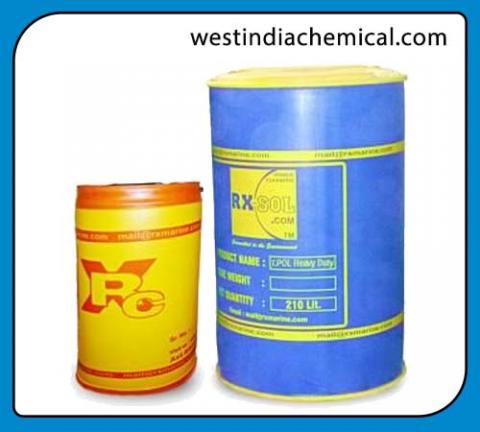Primary tabs

Hydrochloric Acid Conc Pure and Colourless
SKU::RXSOL-16-1101-050
Hydrochloric acid is a strong inorganic acid that is used in many industrial processes. The application often determines the required product quality.
Regeneration of ion exchangers
An important application of high-quality hydrochloric acid is the regeneration of ion exchange resins. Cation exchange is widely used to remove ions such as Na+ and Ca2+ from aqueous solutions, producing demineralized water.
Na+ is replaced by H3O+
Ca2+ is replaced by 2 H3O+
Ion exchangers and demineralized water are used in all chemical industries, drinking water production, and many food industries.
pH Control and neutralization
A very common application of Hydrochloric acid is to regulate the basicity (pH) of solutions.
OH- + HCl H2O + Cl-
In industry demanding purity (food, pharmaceutical, drinking water), high-quality Muriatic acid is used to control the pH of process water streams. In less-demanding industry, technical-quality hydrochloric acid suffices for neutralizing waste streams and swimming pool treatment.
Pickling of steel
Pickling is an essential step in metal surface treatment, to remove rust or iron oxide scale from iron or steel before subsequent processing, such as extrusion, rolling, galvanizing, and other techniques. Technical-quality HCl at typically 18% concentration is the most commonly-used pickling agent for the pickling of carbon steel grades.
Fe2O3 + Fe + 6 HCl 3 FeCl2 + 3 H2O
The spent acid has long been re-used as ferrous chloride solutions, but high heavy-metal levels in the pickling liquor has decreased this practice.
In recent years, the steel pickling industry has, however, developed hydrochloric acid regeneration processes, such as the spray roaster or the fluidized bed HCl regeneration process, which allow the recovery of HCl from spent pickling liquor. The most common regeneration process is the pyrohydrolysis process, applying the following formula:
4 FeCl2 + 4 H2O + O2 8 HCl+ 2 Fe2O3
By recuperation of the spent acid, a closed acid loop is established. The ferric oxide by product of the regeneration process is a valuable by-product, used in a variety of secondary industries.
Hydrochloric Acid is not a common pickling agent for stainless steel grades.
Production of inorganic compounds
Numerous products can be produced with hydrochloric acid in normal acid-base reactions, resulting in inorganic compounds. These include water treatment chemicals such as iron(III) chloride and polyaluminium chloride (PAC).
Fe2O3 + 6 HCl 2 FeCl3 + 3 H2O
Both iron(III) chloride and PAC are used as flocculation and coagulation agents in wastewater treatment, drinking water production, and paper production.
Other inorganic compounds produced with hydrochloric acid include road application salt calcium chloride, nickel(II) chloride for electroplating, and zinc chloride for the galvanizing industry and battery production.
Production of organic compounds
The largest Hydrochloric acid consumption is in the production of organic compounds such as vinyl chloride for PVC, and MDI and TDI for polyurethane. This is often captive use, consuming locally-produced Muriatic acid that never actually reaches the open market. Other organic compounds produced with Muriatic acid include bisphenol A for polycarbonate, activated carbon, and ascorbic acid, as well as numerous pharmaceutical products.
Domestic and Industrial as cleaning Compound :
Hydrochloric acid is a fundamental chemical, and as such it is used for a large number of small-scale applications, such as leather processing, household cleaning, and building construction. In addition, a way of stimulating oil production is by injecting Hydrochloric acid into the rock formation of an oil well, dissolving a portion of the rock, and creating a large-pore structure. Oil-well acidizing is a common process in the North Sea oil production industry.
Many chemical reactions involving Hydrochloric acid are applied in the production of food, food ingredients, and food additives. Typical products include aspartame, fructose, citric acid, lysine, hydrolyzed (vegetable) protein as food enhancer, and in gelatin production. Food-grade (extra-pure) Muriatic acid can be applied when needed for the final product.
Hydrochloric acid is the aqueous solution of hydrogen chloride gas (HCl). It is a strong acid, and the major component of gastric acid. It is also widely used in industry. Hydrochloric acid must be handled with appropriate safety precautions because it is a highly corrosive solution.
Hydrogen chloride (HCl) is a monoprotic acid, which means it can dissociate (i.e., ionize) only once to give up one H+ion (a single proton). In aqueous Muriatic acid, the H+joins a water molecule to form a hydronium ion, H3O+:
HCl + H2O H3O++ Cl-
The other ion formed is Cl-, the chloride ion. Hydrochloric acid can therefore be used to prepare salts called chlorides, such as sodium chloride. Hydrochloric acid is a strong acid, since it is fully dissociated in water.
Monoprotic acids have one acid dissociation constant, Ka, which indicates the level of dissociation in water. For a strong acid like HCl, the Ka is large. Theoretical attempts to assign a Ka to HCl have been made.[3]When chloride salts such as NaCl are added to aqueous HCl they have practically no effect on pH, indicating that Cl-is an exceedingly weak conjugate base and that HCl is fully dissociated in aqueous solution. For intermediate to strong solutions of hydrochloric acid, the assumption that H+molarity (a unit of concentration) equals HCl molarity is excellent, agreeing to four significant digits.
Of the seven common strong acids in chemistry, all of them inorganic, Hydrochloric acid is the monoprotic acid least likely to undergo an interfering oxidation-reduction reaction. It is one of the least hazardous strong acids to handle; despite its acidity, it produces the less reactive and non-toxic chloride ion. Intermediate strength Hydrochloric acid solutions are quite stable, maintaining their concentrations over time. These attributes, plus the fact that it is available as a pure reagent, mean that Hydrochloric acid makes an excellent acidifying reagent and acid titrant (for determining the amount of an unknown quantity of base in titration). Strong acid titrants are useful because they give more distinct endpoints in a titration, making the titration more precise.
|
|
|
|
Properties |
|
|
Molecular formula |
HCl in water (H2O) |
|
Molar mass |
36.46 g/mol (HCl) |
|
Appearance |
Clear colorless to light-yellow liquid |
|
Melting point |
−26°C (247 K) 38% solution |
|
Boiling point |
110 °C (383 K), 20.2% solution; |
|
Solubility in water |
Miscible |
|
Acidity (pKa) |
−8.0 |
|
Viscosity |
1.9 mPa s at 25° C, |
|
Flash point |
Non-flammable |
Hydrochloric Acid Conc Pure and Colourless manufacturer supplier distributor in Mumbai, Kandla, Kolkata, Vizag, Chennai, India, Fujairah, Dubai, Sharjah, UAE, Gulf, Middle East, Muscat Oman, Kenya Africa. Get the best quality of Hydrochloric Acid Conc Pure and Colourless at a competitive price from us. We have ready stock of Hydrochloric Acid Conc Pure and Colourless in India, UAE Gulf, Oman, Kenya Africa. Contact us for bulk as well as small orders.
Safety
Hydrochloric acid in high concentrations forms acidic mists. Both the mist and the solution have a corrosive effect on human tissue, with the potential to damage respiratory organs, eyes, skin, and intestines. Upon mixing Muriatic acid with common oxidizing chemicals, such as bleach (NaClO) or permanganate (KMnO4), the toxic gas chlorine is produced. To minimize the risks while working with hydrochloric acid, appropriate precautions should be taken, including wearing rubber or PVC gloves, protective eye goggles, and chemical-resistant clothing.




